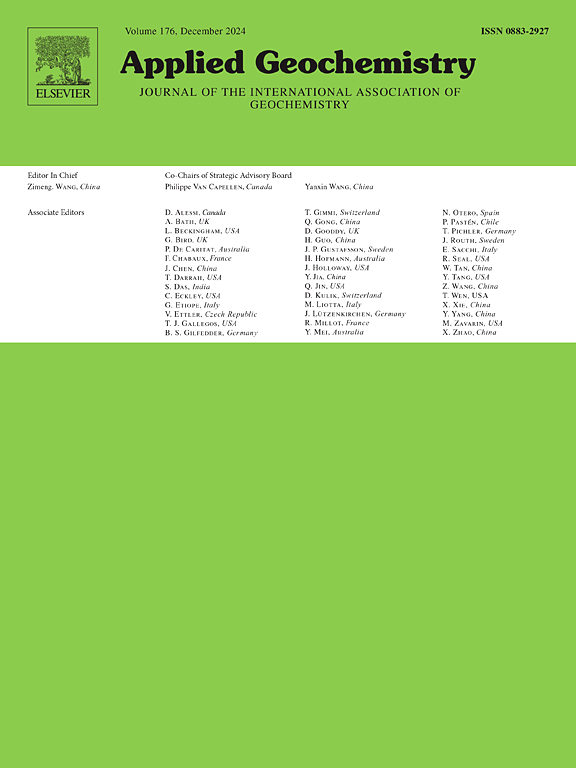Dissolution behavior of mechanical synthetic carbonate mixtures from the system ZnCO3–PbCO3–H2O in aqueous solution at 25 °C
IF 3.1
3区 地球科学
Q1 GEOCHEMISTRY & GEOPHYSICS
引用次数: 0
Abstract
Understanding the ZnCO3–PbCO3–H2O system is still a challenge for the thermodynamical modelling due to the different crystal structures of the two endmembers, rhombohedral smithsonite and orthorhombic cerussite. In the present work, a range of Pb-bearing smithsonite, Zn-bearing cerussite and their mixture having the bulk constituent Pb/(Zn + Pb) mole ratio (XPb) of 0.000–1.000 had been prepared and dissolved in water at 25 °C for 330 days. For dissolution in initially N2-degassed water (NW) and CO2-saturated water (CW), the average log IAPs (ion activity products) at the final stable state (≈log Ksp, solubility product constants) were computed to be −10.71 ± 0.07 ∼ −10.56 ± 0.06 and −10.88 ± 0.23 ∼ −10.89 ± 0.21 for smithsonite, −13.26 ± 0.04 ∼ −13.23 ± 0.08 and −12.72 ± 0.06 ∼ −12.69 ± 0.03 for cerussite, respectively. The incorporation of Pb into smithsonite would slightly increase the log IAPs for the Pb-smithsonite, while very small amount of the Zn incorporation into cerussite would significantly decrease the log IAPs for the Zn-cerussite. The Guggenheim parameters for the smithsonite (R c) – cerussite (Pmcn) solid solutions were estimated to be a0 = 2.79 for the smithsonite-side and a0 = 2.20 for the cerussite-side from the largest XPb in the Pb-smithsonite of 0.094 and the smallest XPb in the Zn-cerussite of 0.751. In the Lippmann diagrams for the smithsonite–cerussite–H2O system, the (Zn1-xPbx)CO3 solids dissolved incongruently, and the aqueous compositions evolved with time upward to the quasi-equilibrium curves for the Pb-smithsonite having a smaller XPb, and then along them from right to left, attained and intersected the solutus curve and the saturation curve for pure smithsonite, and finally moved upward to the saturation curve for cerussite. The Pb-poorer water solutions were finally at equilibrium with both the Zn-richer Pb-smithsonite and the Pb-richer Zn-cerussite. The result can offer a deep understanding of the geochemical and environmental behaviors of lead and zinc.
ZnCO3-PbCO3-H2O体系机械合成碳酸盐混合物在25℃水溶液中的溶解行为
由于ZnCO3-PbCO3-H2O体系的两种端元(菱形smithsonite和正方石cerusite)的晶体结构不同,因此对该体系的热力学建模仍然是一个挑战。本文制备了一种体积成分Pb/(Zn + Pb)摩尔比(XPb)为0.000 ~ 1.000的含铅铁钼矿、含锌锡钼矿及其混合物,并在25℃条件下在水中溶解330天。对于初始n2脱气水(NW)和co2饱和水(CW)的溶解,最终稳定状态下的平均对数IAPs(离子活度产物)(≈log Ksp,溶解度产物常数)分别为- 10.71±0.07 ~ - 10.56±0.06和- 10.88±0.23 ~ - 10.89±0.21,锡铜矿为- 13.26±0.04 ~ - 13.23±0.08和- 12.72±0.06 ~ - 12.69±0.03。Pb掺入铁锌矿会略微增加Pb-铁锌矿的测井iap,而极少量的Zn掺入锡锌矿则会显著降低Zn-锡锌矿的测井iap。从Pb-smithsonite中最大的XPb为0.094,Zn-cerussite中最小的XPb为0.751,估算出smithsonite (R 3 -c) -cerussite (Pmcn)固溶体的Guggenheim参数在smithsonite一侧为a0 = 2.79,在cerussite一侧为a0 = 2.20。在铅锌矿-铬铁矿-水体系的Lippmann图中,(Zn1-xPbx)CO3固体不均匀溶解,水相组成随时间向上演化至XPb较小的铅锌矿的准平衡曲线,然后沿此曲线从右向左到达溶质曲线和纯铅锌矿的饱和曲线相交,最后向上移动至铜矿的饱和曲线。贫铅水溶液最终与富锌铅锌矿和富铅铅锌矿达到平衡。该结果可为深入了解铅、锌的地球化学和环境行为提供依据。
本文章由计算机程序翻译,如有差异,请以英文原文为准。
求助全文
约1分钟内获得全文
求助全文
来源期刊

Applied Geochemistry
地学-地球化学与地球物理
CiteScore
6.10
自引率
8.80%
发文量
272
审稿时长
65 days
期刊介绍:
Applied Geochemistry is an international journal devoted to publication of original research papers, rapid research communications and selected review papers in geochemistry and urban geochemistry which have some practical application to an aspect of human endeavour, such as the preservation of the environment, health, waste disposal and the search for resources. Papers on applications of inorganic, organic and isotope geochemistry and geochemical processes are therefore welcome provided they meet the main criterion. Spatial and temporal monitoring case studies are only of interest to our international readership if they present new ideas of broad application.
Topics covered include: (1) Environmental geochemistry (including natural and anthropogenic aspects, and protection and remediation strategies); (2) Hydrogeochemistry (surface and groundwater); (3) Medical (urban) geochemistry; (4) The search for energy resources (in particular unconventional oil and gas or emerging metal resources); (5) Energy exploitation (in particular geothermal energy and CCS); (6) Upgrading of energy and mineral resources where there is a direct geochemical application; and (7) Waste disposal, including nuclear waste disposal.
 求助内容:
求助内容: 应助结果提醒方式:
应助结果提醒方式:


